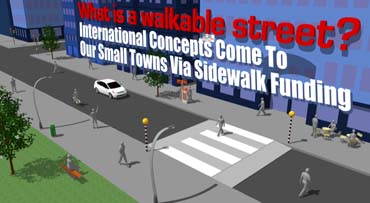Serving the Towns of Wawarsing, Crawford, Mamakating, Rochester and Shawangunk, and everything in between | |||
| |||
|
What Is A Walkable Street?
International Concepts Come To Our Small Towns Via Sidewalk Funding
REGIONAL – Next Friday, September 19, the Catskill Watershed Corporation will sponsor a workshop entitled, "Getting Around: A Workshop on Improving Traffic Flow and Pedestrian Access in our Communities."
The primary discussion will concern the Complete Streets initiative of the NYS Department of Transportation, and there will be presentations by Lois Chaplin, who has long experience as a specialist with the Cornell Local Roads Program, and Nadine Lemmon, Albany Legislative Advocate for the Tri-State Transportation Campaign. What is a Complete Street? A design that considers all the uses and elements that go into a working street in one of our towns or villages. That means sidewalks, bicycle lanes, paved shoulders, signage, crosswalks, pedestrian control signals, bus pullouts, curb cuts, lane striping and traffic calming measures. In 2011, Governor Andrew Cuomo signed the Complete Streets Act, mandating that state, county and local agencies must consider the convenience and mobility of all users when developing transportation projects that receive state and federal funding. Nadine Lemmon explains further. "It's not just about sidewalks, it can be as simple as making sure you have a crosswalk and a countdown clock on a traffic light," she said. "And, important, you have that clock run long enough for seniors to get across the road, because seniors are disproportionately impacted by unsafe streets and they are dying on our roads." With an aging population in our region, this has relevance for all of us sooner or later. "People are talking now about 'aging in place' so people don't have to move somewhere else when they get old and they can stay in their homes. And if they can't cross the road safely to get to the store, then they do have to move away and it costs them and the state a lot of money," Lemmon continued. "An AARP report on the State of the 50 plus population in New York State, found that 80 percent of respondents said street repair was the number one problem. The concern is that older New Yorkers, faced with dangerous and difficult streets without adequate crossings and sidewalks, will move away taking their retirement income with them." At the other end of things there's a trend among the younger generation that seeks walkable towns and suburbs. The first generation of younger Americans to not share the passion for cars and driving is the generation that grew up in suburban pods and now lives by texting. "Even up here in the Hudson Valley, if our communities are walkable, then you will attract some of the younger generation, which is good for business," Lemmon noted. "Complete Streets is really about the whole package." Lois Chaplin took up the gauntlet, and noted how "the Complete Streets goal has been to help communities be more aware of all the elements that make a community safer for everybody. So, it's not just things, it's also policies to make it possible for all people of all ages and abilities to get around and have safe access across our streets." One thing that Chaplin points to is having paved shoulders on more of our roads. "Road shoulders have several good points," she said. "They extend the life of the road and they also increase safety for anyone walking, which might be mothers with small children, or for runners or bicyclists... anyone who just happens to be walking, in fact. The 'Good Roads movement,' which eventually turned into the Federal Highway System, was begun by bicyclists." In our immediate area, some of our towns — like Ellenville — have been fully developed for a long time and have quite a good network of sidewalks. However, it can always be improved. Wawarsing supervisor Lenny Distel is aware of the most glaring, unsafe stretch of street in the area he's lived his life within, and is happy to bring it up. " "Never been happy with the road leading to the Shoprite plaza," he said. "That should have had sidewalks but they weren't put in so we have the seniors in the senior housing complex by the hospital walking down there and it's not safe. So that's an area where I think the town board will be looking to Complete Streets as we go forward." But Distel didn't stop there. "Another thought would be to put in a bridge over the wetlands to reach the Shoprite. We're also going to be looking at that area in connection with the planned new senior development over by the airport," he added. "That will have to have sidewalks included." As well as a possible hook into the region's long-awaited rail trail system between communities. In the Town of Crawford, director of Safety and Security Dan McCann has already tapped into the funding streams available for things like sidewalks. "We are always on the lookout for anything in relation to street safety," he said. "The most recent grant we applied for was through the Transportation Alternatives Program from the DOT. We wanted to get sidewalks from Railroad Avenue to the town park and from North Street to the park. DOT was offering dollars for that." Nadine Lemmon noted that it's in such ways that a big concept ends up working through funding sources. "TAP is one of main funding sources for sidewalks. Communities can get 80 percent of the cost in federal funding, with 20 percent local matching," she said. "And, in addition, sometimes local communities can get state dollars." The workshop will be at the American Legion Post #216, 903 Main Street, Margaretville, from 1 p.m. to 4 p.m. on Friday, September 19. Community leaders, municipal officials. planners and interested individuals are all welcome. Talk about big ideas whose time fits our needs...
Copyright © 2014, Electric Valley Media LLC | Terms of Use
All Rights Reserved. |
     |




